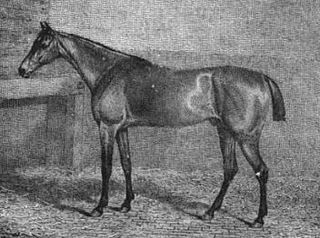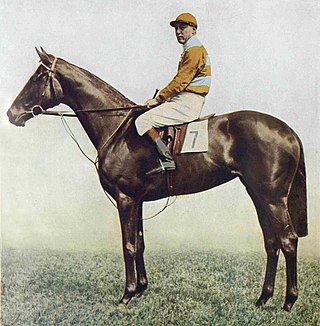
Pocahontas (1837–1870) was an English Thoroughbred racehorse and the dam of three sires who had a great influence on the breed. Although mares are not generally considered to be as influential as sires, Thoroughbred Heritage refers to Pocahontas as "one of the most influential Thoroughbreds of all time, male or female."

Glencoe (1831–1857) was a British bred Thoroughbred racehorse, who won the 2,000 Guineas Stakes and the Ascot Gold Cup. He was one of the earliest Thoroughbred stallions imported into the United States and was a top broodmare sire there. Several outstanding sons of Lexington were out of Glencoe mares, including Asteroid, Kentucky and Norfolk.

Eleanor was a British Thoroughbred racehorse bred by Charles Bunbury and was the first female horse to win The Derby. Eleanor also won the 1801 Epsom Oaks among many other races before retiring from racing at age eight to become a broodmare for Bunbury. She produced the stallion Muley, which in turn sired the mare Marpessa and the influential stallion Leviathan which was exported to the United States in the early nineteenth century. Through the produce of her daughter Active, Eleanor is present in the pedigrees of 19th-century American Standardbred racehorses.

Blucher (1811–1841) was a British Thoroughbred racehorse and sire named after the Prussian General Gebhard Leberecht von Blücher, one of the most successful commanders of the Napoleonic Wars, but his name was invariably spelt without the umlaut.

Jest (1910–1921) was a British Thoroughbred racehorse and broodmare, best known for winning two Classics in 1913. The filly won four times from eight races in a track career which lasted from July 1912 until July 1913. As a two-year-old in 1912 she won twice from four starts. On her three-year-old debut she won the 1000 Guineas over one mile at Newmarket and then won the Oaks over one and a half miles at Epsom a month later. She was retired from racing after being beaten in the Coronation Stakes at Royal Ascot and the Nassau Stakes at Goodwood. As a broodmare she produced the 1921 Epsom Derby winner Humorist before dying at the age of eleven.
Morel was a British Thoroughbred racehorse and broodmare who won the classic Oaks Stakes at Epsom Downs Racecourse in 1808. In a racing career which lasted from April 1808 until July 1812 the mare ran twenty-seven times and won fourteen races. She was mainly campaigned at Newmarket Racecourse, running against some of the best horses of the era in match races and frequently carrying large weights in handicaps. Unlike many champions of the early 19th century, she was particularly effective at shorter distances, recording many of her successes over a mile or less. After her retirement from racing, Morel became a highly successful and influential broodmare, whose direct descendants have won numerous major races in Europe, North America, Japan and Australasia.

Diadem (1914–1931) was a British Thoroughbred racehorse who won the 1000 Guineas in 1917. She went on to become a top sprinter, recording two victories in both the King's Stand Stakes and the July Cup. In total she won 24 of her 39 races. Diadem was bred and owned by Edgar Vincent, 1st Viscount D'Abernon, and trained by George Lambton. The Diadem Stakes at Ascot Racecourse was named after her.
Roussalka was a British Thoroughbred racehorse and broodmare. In a racing career which lasted from May 1974 until July 1976 she won seven of her seventeen races and was placed on four occasions. As a two-year-old in 1974 she won four races including the Cherry Hinton Stakes and the Princess Margaret Stakes. In the following year, she showed her best form in summer, winning the Coronation Stakes and the Nassau Stakes. In 1976 she ran only three times, but became the first filly to win the Nassau Stakes for a second time. She was then retired from racing and became a very successful broodmare.
Hycilla was a British Thoroughbred racehorse and broodmare, who raced during World War II and was best known for winning the classic Oaks Stakes in 1944. Unraced as a juvenile, she finished second on her three-year-old debut before winning the Oaks, which was run that year at Newmarket Racecourse. She was beaten when favourite for St Leger but ended her year with a win in the Champion Stakes. In the following year, she failed to win but ran well in defeat when third in a strongly-contested Coronation Cup. She retired to become a broodmare in the United States but made little impact, producing four minor stakes winners.
Swan Princess was a British Thoroughbred racehorse and broodmare. As a two-year-old in 1980 she showed exceptional speed but was also temperamental and difficult to restrain. She won two minor races and finished second in both the National Stakes and the Molecomb Stakes before recording her biggest win in the Phoenix Stakes. She won one minor race from four attempts ain 1981 before being retired from racing. As a broodmare she produced several minor winners.

Pia was a British-bred Thoroughbred racehorse and broodmare. She showed top-class form as a juvenile in 1966 when she won three races including the Cherry Hinton Stakes and the Lowther Stakes as well as finishing second in the Cheveley Park Stakes. In the following year she ran fourth in the 1000 Guineas and third in the Musidora Stakes before recording her biggest win in the Epsom Oaks. Later that year she dead-heated for first place in the Park Hill Stakes and ran fourth in a strong renewal of the Champion Stakes before being retired from racing. Although her foals made little impact on the track, her daughter Principia became an influential broodmare.

Homeward Bound was a British Thoroughbred racehorse and broodmare. After finishing unplaced on her only appearance as a juvenile she emerged as a top class performer in the following year, winning the Princess Elizabeth Stakes, Epsom Oaks and Yorkshire Oaks. She never won again but was placed in both the Coronation Cup and the Doncaster Cup as a four year old. After her retirement from racing she became a broodmare and had some success as a dam of winners.
Lovely Rosa was an Irish-bred, British-trained Thoroughbred racehorse and broodmare best known for her win in the 1936 Epsom Oaks. As a juvenile in 1945 she showed some promise when finishing second in the Queen Mary Stakes and winning a race at Newbury but then showed little worthwhile form until her 33/1 upset victory in the Oaks. She never won again and was retired at the end of 1936. She had some success as a broodmare, most notably being the grand-dam of Wilwyn.

Straitlace was a British Thoroughbred racehorse and broodmare. As a two-year-old she was one of the best fillies of her generation in England when she won five of her eight races. In the following year she finished third in the 1000 Guineas before going on to win the Epsom Oaks, Coronation Stakes and Nassau Stakes, as well as three other races. She earned more money than any other horse in Britain in 1924 and was retired after winning eight of her sister races. Straitlace was exported to France in 1925 and became a very successful and influential broodmare.
Brownhylda was a British Thoroughbred racehorse and broodmare. She showed considerable promise as a two-year-old when she won three times and finished twice on two occasions. In the following year he won the Epsom Oaks and the Park Hill Stakes as well as finishing second in the Yorkshire Oaks. Her form declined thereafter and she failed to win again before being retired at the end of the following year. She produced only four known foals, but these did include the St Leger winner Firdaussi.

Love in Idleness was a British Thoroughbred racehorse and broodmare. Her diminutive stature and courageous racing style made her one of the most popular horses of her time. She showed very promising form as a two-year-old in 1920 when she won four time from five starts. In the following year she was arguably the best three-year-old filly in England as she won the Epsom Oaks, Sandringham Stakes, Yorkshire Oaks and Park Hill Stakes. After retiring from racing he had some success as a dam of winners.
Silver Urn was an Irish-bred, British-trained Thoroughbred racehorse and broodmare. As a two-year-old she showed little ability but in the following spring she won two valuable handicap races and then recorded her biggest win in the 1000 Guineas. On her next appearance she sustained career-ending injuries in the Epsom Oaks and never raced again. She had some success as a dam of winners.

Limasol (1894–1916) was a British Thoroughbred racehorse and broodmare. She showed promising form as a two-year-old despite failing to win any of her three starts and recorded her biggest success on her three-year-old debut when she upset the odds-on favourite Chelandry to take the Epsom Oaks. She was subsequently campaigned over extreme distances against male opposition and never won again. She made no impact as a broodmare.

Memoir was a dual classic-winning British Thoroughbred racehorse and broodmare. As a two-year-old in 1889 she showed considerable promise as she won the last three of her six races. In the following spring she appeared an unfortunate loser when stable arrangements prevented her from beating Semolina in the 1000 Guineas but she went on to win the Newmarket Stakes, Oaks Stakes, Nassau Stakes, St Leger and Newmarket Oaks. She added a win in the July Cup before being retired at the end of 1891. Although she produced no major winners, she had an enduring influence through her daughter, Miss Gunning.
Cachet is an Irish-bred, British-trained Thoroughbred racehorse. As a two-year-old in 2021 she won only one minor race but showed promising form as she finished second in the Rockfel Stakes, third in the Fillies' Mile and third in the Breeders' Cup Juvenile Fillies Turf. In the following spring she improved to win the Nell Gwyn Stakes and the 1000 Guineas.












